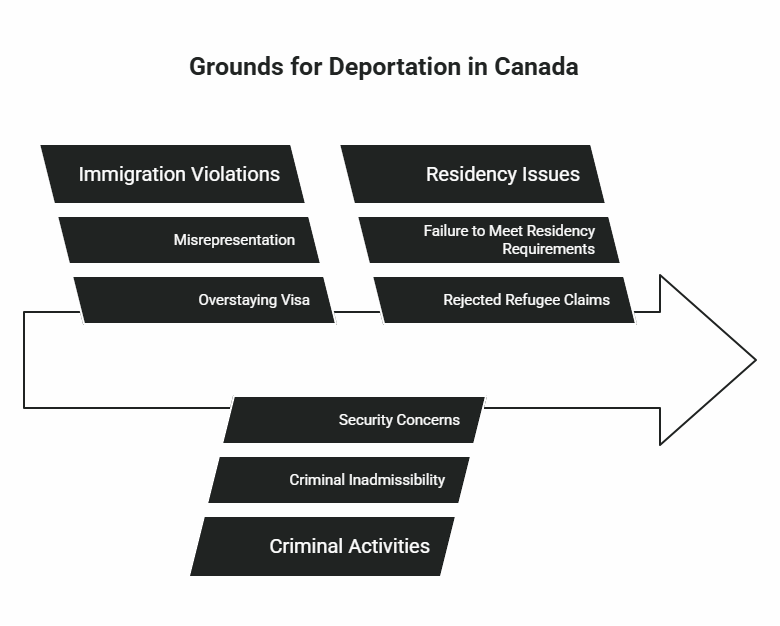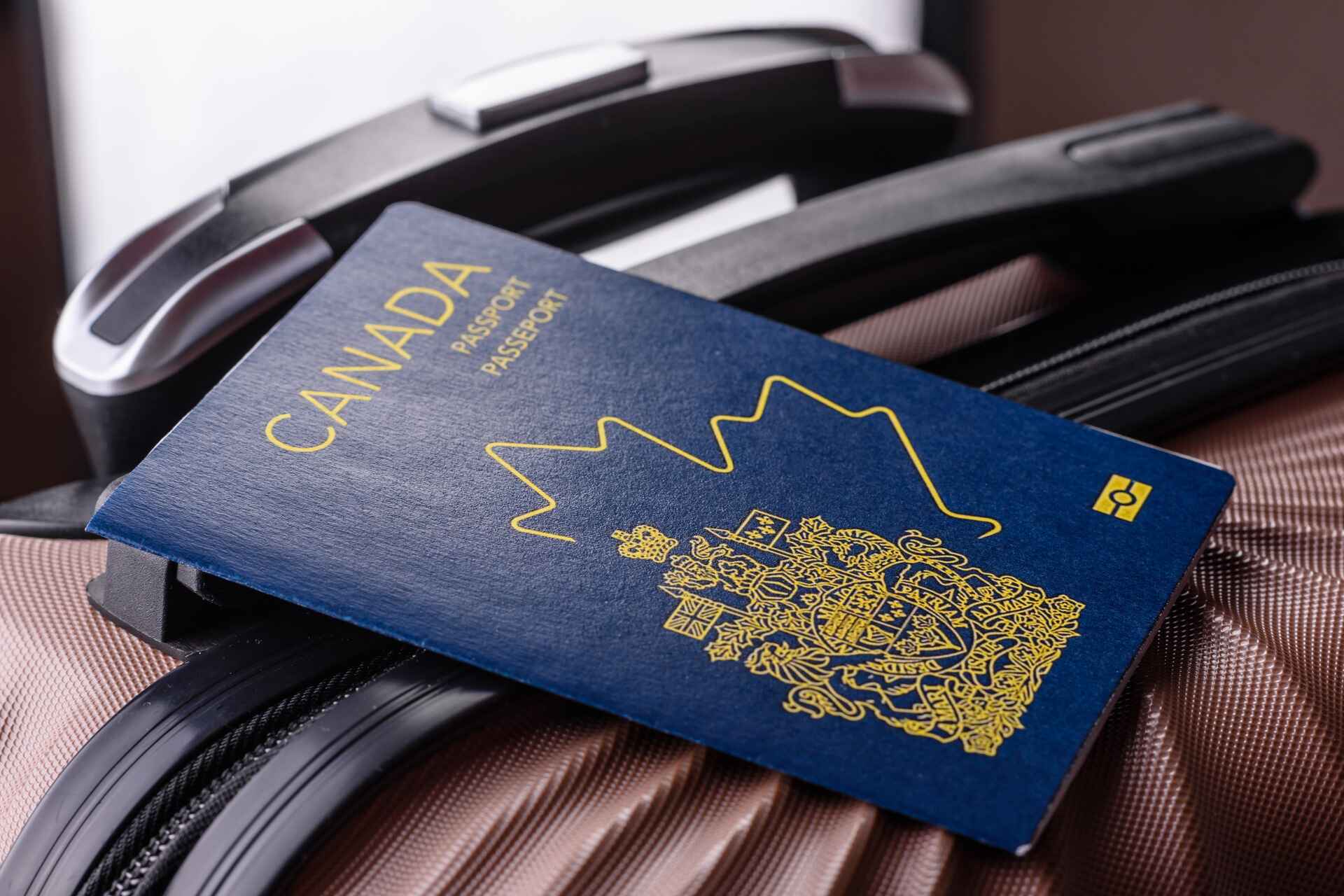
Facing deportation from Canada can be an overwhelming and stressful experience. Whether you’re a permanent resident, a temporary visa holder, or an asylum seeker, receiving a removal order can disrupt your life, separate you from your loved ones, and impact your future immigration prospects.
This guide is designed to provide clear, step-by-step information about the deportation process in Canada, including the different types of removal orders, your legal rights, and the options available to fight deportation or return to Canada after removal.
There are scenarios that can cause deportation from Canada, including:
If you receive a removal order, time is critical. You may have options to challenge or delay your deportation, but acting quickly is essential. Throughout this guide, we will explain the different types of removal orders, the appeals process, the legal remedies available, and how to handle the system effectively.
At Kingwell Immigration Law, we have helped countless individuals fight removal orders, stay in Canada legally, and even return after deportation.
Additional reading: PR card expired
If you or a loved one is facing deportation, contact our Canada deportation lawyer immediately for a consultation—because in immigration cases, every moment counts.
Yes, you can get deported in Canada. Even individuals with permanent resident status can be subject to deportation from Canada under certain conditions.
While Canadian immigration law upholds fairness and due process, there are legal grounds under which someone can be removed from the country.
Deportation is not an automatic outcome. The Canada Border Services Agency (CBSA) and Immigration, Refugees and Citizenship Canada (IRCC) must follow legal procedures, including issuing a removal order.
Depending on the type of removal order and the individual’s status, there may be an opportunity to appeal, apply for a stay, or request discretionary relief such as a humanitarian and compassionate (H&C) application.
If you’ve received a removal order or believe you may be at risk of deportation, it’s essential to act quickly and speak with a qualified immigration lawyer. At Kingwell Immigration Law, we help clients understand their legal position, explore all available options, and advocate for their right to remain in Canada.
Yes, you can be deported from Canada for a criminal offence, even if you’re classed as a permanent resident. Under the Immigration and Refugee Protection Act (IRPA), individuals who are not Canadian citizens may be found inadmissible on the grounds of criminality or serious criminality.
Criminality includes offences such as theft, impaired driving, or assault that carry a potential sentence of fewer than 10 years. Serious criminality typically refers to more serious charges, such as aggravated assault, robbery, drug trafficking, or any crime with a sentence of 10 years or more, or where a sentence of six months or more has been imposed.
A conviction is not the end of the road. Individuals facing removal for criminal inadmissibility may still have options, including:
Deportation in Canada is a legal process carried out by the Canada Border Services Agency (CBSA) under the Immigration and Refugee Protection Act (IRPA).
Canada’s immigration system prioritises fairness and public safety, but certain violations of immigration or criminal law can result in removal orders. Below are the main grounds that can lead to deportation from Canada:
Overstaying your authorized stay in Canada, whether on a visitor, study, or work visa, can be treated as a violation of immigration law, especially if it appears intentional or prolonged.
If discovered, the Canada Border Services Agency (CBSA) may issue a departure or deportation order depending on the circumstances. Individuals may still be able to apply for restoration of status, but timing is critical. Legal guidance can help determine if you qualify and how best to proceed.
Misrepresentation refers to providing false or misleading information to Immigration, Refugees and Citizenship Canada (IRCC). This can include lies or omissions on application forms, fake documents, or failure to disclose important details, such as previous visa refusals.
Even unintentional errors can be considered misrepresentation, and the consequences are severe. You may be banned from re-entering Canada for five years and lose permanent resident status. If accused, it is crucial to act quickly and seek legal advice to respond with corrective documentation or challenge the finding.
Being convicted of a criminal offence, either in Canada or abroad, can make you inadmissible and lead to deportation. This includes both serious crimes, such as assault or drug trafficking, and some offences that might be considered minor elsewhere but are treated seriously under Canadian law.
Permanent residents are not immune — a criminal conviction can trigger a removal order and loss of status. In some cases, individuals may be eligible for a record suspension, rehabilitation, or appeal.
If Canadian authorities believe that a person poses a threat to national security, such as having ties to terrorism, espionage, or organized crime, they may issue a deportation order under section 34 of the Immigration and Refugee Protection Act (IRPA).
Security-based removals are among the most serious forms of deportation and often involve confidential evidence. Individuals facing such allegations have limited avenues for appeal, making legal representation essential. In some instances, challenges may be brought through judicial review or humanitarian applications.
Permanent residents must live in Canada for at least 730 days within five years to retain their status. If you fail to meet this requirement, especially without qualifying exceptions (e.g., accompanying a Canadian citizen abroad), you could be found inadmissible.
Residency obligation breaches are a common reason for PR card renewals to be denied. However, depending on your circumstances, you may be able to argue your case on humanitarian and compassionate grounds or appeal the decision before the Immigration Appeal Division (IAD).
If your refugee claim is denied and all appeals or reviews are exhausted, you may receive a removal order. Refugee claimants whose applications are rejected lose their legal status in Canada and are expected to leave the country.
However, some rejected claimants may be eligible to apply for a Pre-Removal Risk Assessment (PRRA) or stay their removal under humanitarian grounds. If you believe you face risk upon return to your home country, legal support is crucial in submitting urgent applications or requesting protection from removal.

The Canadian deportation process typically starts with an investigation into a person’s immigration status, which can lead to the issuance of a removal order.
The deportation process often starts when a Canada Border Services Agency (CBSA) officer or an Immigration, Refugees and Citizenship Canada (IRCC) official believes that a person may be inadmissible to Canada.
If they determine that there are grounds for removal, which could lead to deportation from Canada, they prepare a Section 44 Report, which is submitted to a CBSA delegate for review.
At this stage, one of three things can happen:
A removal order can be issued in different ways, depending on the circumstances:
Once a removal order is issued, CBSA sets a timeline for departure based on the type of order. If you fail to leave Canada within the required time, your removal order may escalate to a Deportation Order, which carries more severe consequences.
Can a Removal Order Be Challenged?
Yes! Depending on the type of removal order, you may have options to:
| Type of Removal Order | What It Means | Can You Return to Canada? |
|---|---|---|
| Departure Order | Must leave Canada within 30 days and confirm departure with CBSA. | Yes, no restrictions, if you comply with the order. |
| Exclusion Order | Must leave Canada and cannot return for 1 year (or 5 years in cases of misrepresentation). | After the exclusion period, you can return without special permission. If you return earlier, you must apply for an Authorization to Return to Canada (ARC). |
| Deportation Order | Permanent removal from Canada, with a lifetime ban. | You must apply for an Authorization to Return to Canada (ARC) before being allowed back. |
A Departure Order is the least serious type of removal order. It requires you to:
What Happens If You Don’t Leave in Time?
If you fail to leave within 30 days or don’t confirm your departure with CBSA, your Departure Order automatically becomes a Deportation Order, which has much more serious consequences.
How We Can Help: If you receive a Departure Order, we will help ensure you leave properly, preserving your ability to return to Canada in the future.
An exclusion order in Canada requires you to leave Canada and prohibits you from returning for:
How to Return After an Exclusion Order:
What Happens If You Try to Re-Enter Canada Without ARC?
Trying to enter Canada before the exclusion period ends without an ARC can lead to denied entry and even more severe immigration consequences.
How We Can Help: We assist clients in filing strong ARC applications to improve their chances of returning to Canada after an Exclusion Order.
A Deportation Order is the most serious removal order. It is often issued when:
What Are the Consequences?
A Deportation Order permanently bars you from returning to Canada unless you obtain an Authorization to Return to Canada (ARC).
How to Return After a Deportation Order:
How We Can Help: We can assess your chances of ARC approval and prepare a strong application. If you have criminal inadmissibility, we can also explore rehabilitation options to improve your chances of returning.
Canada’s deportation process is governed primarily by the Immigration and Refugee Protection Act (IRPA), which outlines when and how a non-citizen can be removed from the country. Deportation is a legal mechanism used by Canadian immigration authorities to enforce compliance with the country’s immigration rules, but understanding the law reveals that deportation is not automatic, and rights do exist at every stage.
Deportation typically occurs after a removal order has been issued, and that order becomes enforceable only after all appeal rights have been exhausted or waived. Most removal orders stem from findings of inadmissibility, which can result from reasons such as:
The legal concept of inadmissibility under IRPA is broad, and this is where expert legal advocacy plays a role. A finding of inadmissibility doesn’t mean immediate removal; there are often grounds to challenge or mitigate the impact, especially if removal would violate constitutional rights or humanitarian principles.
At Kingwell Immigration Law, we go beyond the surface of immigration enforcement. We work with the IRPA, case law from the Immigration and Refugee Board (IRB), and recent Federal Court decisions to identify strategic defences and legal arguments — including procedural fairness violations, Charter protections, and alternative remedies like a stay of removal, PRRA applications, or Humanitarian and Compassionate (H&C) relief.
In short, deportation law in Canada is not just about removal — it’s about due process. With the right legal support, individuals can assert their rights and, in many cases, delay or overturn a removal order based on legal error, new evidence, or discretionary relief.
If you have received a removal order, you may have legal options to challenge it and stay in Canada. However, acting quickly is essential—missing a deadline could mean losing your right to appeal or apply for a stay of removal.
These are the main ways to fight deportation, with the help of our lawyers:
If you are a permanent resident or a protected person, you may be able to appeal your removal order to the Immigration Appeal Division (IAD).
Who Can Appeal?
Who Cannot Appeal?
How the IAD Appeal Process Works
How We Can Help: Our legal team handles IAD appeals, builds strong legal arguments, and represents clients in hearings.

If you are not eligible for an IAD appeal, you may be able to challenge your removal order through the Federal Court of Canada by requesting a judicial review.
What is a Judicial Review?
How the Process Works
Important: A judicial review does not automatically stop your removal. You must also request a stay of removal to delay deportation while your case is heard.
How We Can Help: We represent clients in judicial reviews and stay applications, giving them the best chance of stopping deportation.
If you cannot appeal or file for judicial review, you may apply for permanent residence on humanitarian and compassionate (H&C) grounds to stop removal.
Who Can Apply?
How We Can Help: We assist clients in building strong H&C applications with supporting evidence.
A Pre-Removal Risk Assessment (PRRA) allows you to stay in Canada if returning to your home country would put you at risk of persecution, torture, or serious harm.
Who Can Apply?
Who Cannot Apply?
How We Can Help: We prepare strong PRRA applications with legal arguments and supporting evidence.
If you have received a removal order, you may be able to delay or stop your deportation through legal actions. The Canadian immigration system provides several options for individuals facing removal, depending on their circumstances, including:
A Pre-Removal Risk Assessment (PRRA) allows individuals to argue that returning to their home country would put them in danger. If successful, a PRRA can prevent deportation and allow the applicant to remain in Canada.
Who Can Apply for a PRRA?
Who Cannot Apply?
How a PRRA Can Stop Removal
How We Can Help: We prepare strong PRRA applications with compelling evidence to increase the chances of success.

A Temporary suspension of removals (TSR) is issued by the Canadian government when conditions in a particular country are deemed unsafe for deportation.
Who Benefits from a TSR?
How a TSR Can Stop Removal
How We Can Help: We monitor TSR updates and assist clients in applying for alternative legal status in Canada while a TSR is in place.
An Administrative deferral of removals (ADR) is a temporary pause on deportations to specific countries experiencing sudden humanitarian crises (such as war or natural disasters). As part of the immigration process, ADRs provide relief to individuals who may otherwise face removal.
Who Qualifies for an ADR?
How an ADR Can Stop Removal
If an ADR is issued, affected individuals cannot be deported until the situation in their home country improves. While ADRs offer temporary protection, there are exceptions for deportation, such as cases involving criminal activity or security risks. Unlike a TSR, an ADR is short-term and subject to change.
How we can help: We track ADR policies and help clients apply for work permits, study permits, or permanent residence while waiting for a long-term solution within the immigration process.
If you do not qualify for a PRRA, TSR, or ADR, you may be able to apply for a stay of removal through the courts. A stay of removal is a legal order that temporarily stops deportation while a case is under review.
Who Can Apply for a Stay of Removal?
How a Stay of Removal Can Stop Deportation
How We Can Help: We file stay of removal applications to stop deportations and provide legal representation in Federal Court cases.
Failing to comply with a removal order can lead to serious consequences, depending on the breach of terms:
What You Can Do: If you cannot leave due to valid reasons (medical emergency, lack of travel documents), seek legal advice immediately to apply for a stay of removal or alternative status.
If you have been removed from Canada, re-entry may be possible depending on the type of removal order issued.
Applying for an ARC:

If a final decision has been rendered and removal is ordered, the CBSA will proceed with deportation. In some cases, an officer may accompany you on your departure to ensure compliance.
For those facing Canadian deportation matters, there may still be options, such as applying for a work permit or a study permit while pursuing legal avenues to remain in Canada.
We track key highlights of Canadian immigration regulations and help clients explore options, including applying on humanitarian grounds. If you or a loved one are facing removal, it’s important to seek legal advice as soon as possible.
At Kingwell Immigration Law, we specialize in:
Every removal case is different. Book a consultation today with our Canada deportation lawyer today for legal advice tailored to your situation.
A recognized refugee in Canada is generally protected from deportation. However, they can be removed if they commit serious crimes, pose a security threat, or if their refugee status is revoked due to misrepresentation. In such cases, they may lose protection and face a deportation order after due process.
Yes, you can voluntarily leave Canada before being forcibly removed. This is known as a departure order, which allows you to leave without facing an automatic ban from returning. However, if you fail to leave within 30 days, the departure order becomes a deportation order, making future re-entry more difficult.
If your deportation order is due to a criminal offence, you may be able to challenge it by appealing to the Immigration Appeal Division (IAD) (if eligible), seeking criminal rehabilitation, or applying for a stay of removal. Depending on your case, you may also pursue humanitarian and compassionate relief to remain in Canada.
Your immigration status affects your options for fighting deportation. Permanent residents can appeal certain removal orders, while refugees may be protected unless their status is revoked. Temporary residents, such as work or study permit holders, generally have fewer legal avenues and may be removed more quickly if they violate immigration laws.
Deportation can have serious consequences for your family, especially if they depend on you financially or emotionally. If you are removed, your spouse and children may also face status complications, particularly if they rely on your immigration status. In some cases, family sponsorship applications may be affected or cancelled.
Yes, it is possible to return to Canada after deportation, but you must first apply for an Authorization to Return to Canada (ARC). Approval is not guaranteed and depends on your immigration history, reason for removal, and current circumstances. Legal guidance significantly improves your chances of success.
181 University Ave
Suite 2200
Toronto, ON
M5H 3M7
All content ©2022-2024 Kingwell Immigration Law. All rights reserved. Privacy Policy.